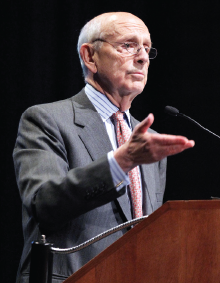“You have to know something about what goes on beyond our shores in order to answer certain questions of law here in the United States,” said U.S. Supreme Court Justice Stephen Breyer last month at APA’s 2016 Annual Meeting in Atlanta. “If you don’t know at least something about international law, the answer to a question of law here will not be fully informed. And the number of those kinds of cases is growing.”
Breyer was speaking about his latest book, The Court and the World: American Law and the New Global Realities. His comments on the book were in response to a question from friend and past APA President Alan Stone, M.D., who was instrumental in bringing Breyer to the APA meeting.
But the bulk of Breyer’s comments gave a lively, engaging, and impromptu—and frequently funny—description of the work-a-day life of the highest court in the land. “People have arguments, some people don’t get over their arguments, they go to lawyers who are supposed to help people get over their arguments—that’s called ‘settling out of court.’ When they can’t settle, they wind up in a courtroom.”
From there, court decisions can be appealed—many times—through district and circuit courts, state supreme courts, or federal appeals courts until they come to the Supreme Court. Some 7,000 to 8,000 cases a year request hearings before the Supreme Court, and only some 80 cases are heard.
“The criterion for whether cases get heard by the court is whether there is a division of opinion in the lower courts,” Breyer said. That is, the court primarily takes cases to resolve a conflict among the lower courts on important questions of federal law.
He described a remarkably orderly process by which the justices read, debate, and eventually decide cases—many of them mundane and unremarkable, and many others momentous in their consequences. He quoted Justice Anthony Kennedy as telling Breyer when he joined the court, “It’s much more like an express train than you have ever imagined.”
Breyer, who was appointed to the court by President Bill Clinton in 1994, is known for his pragmatic approach to constitutional law. Introducing Breyer before his remarks, outgoing APA President Renée Binder, M.D., called Breyer a “champion of the Constitution as a ‘living document’ that needs to take into account contemporary issues.”
Breyer said the relationship among the justices—despite abiding differences in outlooks on law and the Constitution—are without rancor. “I have never heard a raised voice or a derisive comment from anyone about another justice,” Breyer said. “We have lunch together, sometimes we play bridge together. It’s not ‘slap on the back, let’s go to the bar,’ but it’s cordial, respectful, and professional.”
Breyer said the orderliness of the court, along with its processes, is one of the great achievements of the United States. He noted that some highly controversial decisions by the court may have had large segments of the population angry or even furious (he cited, for instance, the 2000 case in which the court’s decision effectively decided the contested 2000 presidential election).
“Sometimes you may hear a decision and wish there were riots in the streets,” Breyer said. “But before you wish that, I’d ask you to turn on your television set and see what happens in other countries where questions of law are not decided as we do. That is a treasure of the United States—that we do decide our differences of opinion about questions of the law, under the law. That’s a very, very good thing, and it works very well.” ■

